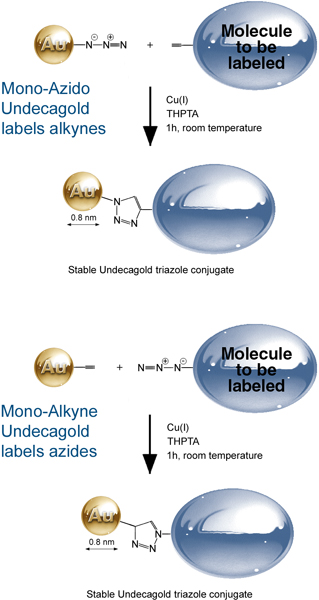Mono-Sulfo-NHS-Undecagold
Referencia N-2045-50NMOL
embalaje : 50nmol
Marca : Nanoprobes
Ultra-small --The best choice for Cryo-EM.
|
|
Undecagold (Au11) is smaller than Nanogold®, with a core of 11 gold atoms only 0.8 nm in diameter. It is ideal for ultra-high-resolution EM work such as cryo-EM, scanning transmission electron microscopy (STEM), or for resolving elements of large structures by TEM in conjunction with image processing. Undecagold has been used to see the biotin binding sites on avidin to 1 nm resolution by electron microscopy. It is prepared in a form with one reactive arm for cross-linking to a specific site on a target molecule, and is available with different reactivities for labeling different sites.
- Ultra small 0.8 nm gold core.
- Use to prepare the smallest possible gold probes.
- Highest possible resolution.
- Site specific covalent labeling with choice of reactivities.
Note: Undecagold is perfect for labeling in high-resolution applications like cryo-EM, but single Undecagold clusters are not routinely visualized directly in the TEM. For standard TEM, Undecagold may be seen upon image processing of protein helices and crystals, or visualized en masse if there is a bulk deposition such as staining of an organelle. Also, Undecagold develops more slowly and with less final developer deposition during silver enhancement or gold enhancement than with our larger, 1.4 nm Nanogold®. Therefore, for many applications we recommend 1.4 nm Nanogold®.

Structure of undecagold showing the [Au11] core, coordinated ligands and peripheral reactive group (maleimide).
Applications
- Cryo-EM - use ultra-small Undecagold for your highest-resolution, cryo-electron microscopy applications.
- Scanning transmission electron microscopy (STEM). [References]
- Undecagold labeling identifies fibrinogen cross-linking site. (Mosesson et al., 1998)
- Labeling of F-actin at the Cys-374 residue by reacting with monomalemido undecagold; data was collected from frozen hydrated samples in the EM and image processing used to map the distribution of label
- Milligan, R.A., et al.: Molecular structure of F-actin and location of surface binding sites. Nature, 348, 217-221 (1990)).
- Labeling of a cysteine in cytochrome oxidase crystals and EM visualization in uranyl acetate/glucose using image processing.
- Crum, J., Gruys, K.J., and Frey, T.G. Electron microscopy of cytochrome c oxidase crystals: labeling of subunit III with a monomaleimide undecagold cluster compound. Biochemistry. 1994 Nov 22;33(46):13719-26.
- tRNA labeling with undecagold using a modified nucleic acid base
- Blechschmidt, B., Shirokov, V., and Sprinzl M. Undecagold cluster modified tRNA (Phe) from Escherichia coli and its activity in the protein elongation cycle. J. Biochem., 219, 65-71 (1994). )
- Localization of the C terminus of the assembly domain of hepatitis B virus capsid protein by electron microscopy, with image processing
- Zlotnick, A., Cheng, N., Stahl, S. J., Conway, J. F., Steven, A. C., and Wingfield, P. T.: Localization of the C terminus of the assembly domain of hepatitis B virus capsid protein: Implications for morphogenesis and organization of encapsidated RNA; Proc. Natl. Acad. Sci. USA, 94, 9556-9561 (1997).
- Isomorphous heavy atom replacement in crystallography of large structures by EM crystallography, single particle alignment work, or X-ray diffraction. Provides a signal much greater than a single heavy atom label
- Thygesen, J., Weinstein, S., Franceshi, F., and Yonath, A.: The suitability of multi-metal clusters for phasing in crystallography of large macromolecular assemblies [review]; Structure, 4, 513-518 (1996). [Full PDF available here]
- Labeling carbohydrates on a glycoprotein: sugars are first oxidized to produce aldehydes, which react with the monamino undecagold.
- Lipka, J.J., Hainfeld, J.F., and Wall, J.S. Undecagold labeling of a glycoprotein: STEM visualization of an undecagoldphosphine cluster labeling the carbohydrate sites of human haptoglobin-hemoglobin complex. J. Ultrastruct. Res., 84, 120 (1983).
Undecagold (Au11) Labeling Reagents
Monomaleimido-Undecagold
The simple-to-use activated Maleimido-undecagold reagent is used for labeling thiols with undecagold. It will specifically label free sulfhydryls in proteins, antibodies, peptides, substrates or other molecules containing a free thiol. For use, it is simply dissolved in water and mixed with the material to be labeled for a few hours. Undecagold conjugates are then isolated by gel filtration.
Applications:
- Create your own small gold probes by linking Au11 to your primary antibody Fab' fragments.
- Label proteins directly for high resolution, site specific identification.
- Label peptides containing cysteine.
Mono-Sulfo-NHS-Undecagold
This reagent is used to covalently attach undecagold to primary amines.
Applications:
- Label proteins which do not contain a cysteine.
- Label peptides at the N-terminal.
- Undecagold-label small molecules as inhibitors or substrate analogs for probing transition state structures.
Click Undecagold
|  |
Monoamino Undecagold
Use this reagent to label carbohydrates and glycoproteins, or activate with a heterobifunctional cross-linking reagent for different reactivity.
Charged Undecagold
Positively and negatively charged undecagold may be used as ionic labels, to stain biological structures with opposite charges. Positive undecagold has multiple amines on its surface and may therefore stain negatively charged features; negatively charged undecagold has multiple carboxyl groups, and will stain features containing many positively ionizing groups.
Non-Functionalized Undecagold
Non-fuctionalized undecagold is an inert, stable form of the undecagold particle with no reactive chemical functionalities or specific affinity properties.
Applications:
- As a size standard for calibration in high-resolution electron microscopy.
- Sizing pores (see: Schwartz, M. P., and Matouschek, A.: The dimensions of the protein import channels in the outer and inner mitochondrial membranes. Proc. Natl. Acad. Sci. USA, 96, 13086-13090 (1999)). [Complete references]
- For tracing contiguous interior spaces in cells and tissues.
Custom Undecagold Conjugates
Nanoprobes does not stock undecagold conjugates, but we will be glad to prepare them to order as a custom synthesis. Let us know your needs, and we'll give you a quote: Use our online form, e-mail us at info@clinisciences.com, or call us at 877-447-6266 (US toll-free number) or (631) 205-9490. We look forward to working with you!



